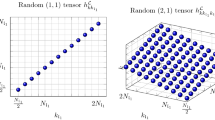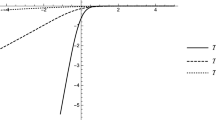Abstract
We study a one-dimensional lattice gas where particles jump stochastically obeying an exclusion rule and having a “small” drift toward regions of higher concentration. We prove convergence in the continuum limit to a nonlinear parabolic equation whenever the initial density profile satisfies suitable conditions which depend on the strengtha of the drift. There is a critical valuea c ofa. Fora<a c, the density values are unrestricted, while fora⩾a c, they should all be to the right or to the left of a given interval ℐ(a). The diffusion coefficient of the limiting equation can be continued analytically to ℐ(a), and, in the interior of ℐ(a), it has negative values which should correspond to particle aggregation phenomena. We also show that the dynamics can be obtained as a limit of a Kawasaki evolution associated to a Kac potential. The coefficienta plays the role of the inverse temperatureβ. The critical value ofa coincides with the critical inverse temperature in the van der Waals limit and ℐ(a) with the spinodal region. It is finally seen that in a scaling intermediate between the microscopic and the hydrodynamic, the system evolves according to an integrodifferential equation. The instanton solutions of this equation, as studied by Dal Passo and De Mottoni, are then related to the phase transition region in the thermodynamic phase diagram; analogies with the Cahn-Hilliard equations are also discussed.
Similar content being viewed by others
References
C. Appert and S. Zaleski, Lattice gas with a liquid-gas transition,Phys. Rev. Lett. 64:1–4 (1990).
A. DeMasi, R. Esposito, J. L. Lebowitz, and E. Presutti, Hydrodynamics of stochastic HPP cellular automata,Commun. Math. Phys. 125:127–145 (1989).
A. DeMasi and E. Presutti, Lectures on the collective behavior of particle systems, CARR Reports in Mathematical Physics, No. 5/89 (November 1989).
A. DeMasi, E. Presutti, and E. Scacciatelli, The weakly asymmetric simple exclusion process,Ann. Inst. H. Poincaré A 25:1–38 (1989).
R. Monaco (ed.),Discrete Kinetic Theory, Lattice Gas Dynamics and Foundations of Hydrodynamics (World Scientific, Singapore, 1989), pp. 384–393.
U. Frisch, B. Hasslacher, and Y. Pomeau, Lattice gas automata for Navier-Stokes equation,Phys. Rev. Lett. 56:1505–1508 (1986).
H. Furukawa, Dynamic scaling assumption for phase separation,Adv. Phys. 34:703 (1985).
J. D. Gunton, M. San Miguel, and P. S. Sahni, inPhase Transitions and Critical Phenomena, Vol. 8, C. Domb and J. L. Lebowitz, eds. (Academic Press, New York, 1983).
M. Z. Guo, G. C. Papanicolaou, and S. R. S. Varadhan, Non linear diffusion limit with nearest neighbor interactions,Commun. Math. Phys. 118:31–59 (1988).
M. Kolb, T. Gobron, J. F. Gouyet, and B. Sapoval, Spinodal decomposition in a concentration gradient,Europhys. Lett. 11:601–606 (1990).
O. Ladyzenskaja, V. Solonmikov, and N. Ural'ceva,Linear and Quasi Linear Equations of Parabolic Type (Translation of Mathematical Monographs, Vol. 23, 1968).
J. S. Langer, Theory of condensation points,Ann. Phys. (NY) 41:108–157 (1967).
J. S. Langer, Theory of the decay of metastable states,Ann. Phys. (NY) 54:258–275 (1969).
J. S. Langer, Theory of spinodal decomposition in alloys,Ann. Phys. (NY) 65:53 (1971).
J. L. Lebowitz, E. Orlandi, and E. Presutti, Convergence of stochastic cellular automaton to Burgers' equation: Fluctuations and stability,Physica D 33:165–188 (1988).
J. Lebowitz and O. Penrose, Rigorous treatment of the van der Waals Maxwell theory of the liquid vapour transition,J. Math. Phys. 7:98 (1966).
J. L. Lebowitz, E. Presutti, and H. Spohn, Microscopic models of hydrodynamic behavior,J. Stat. Phys. 51:841–862 (1988).
O. Penrose and J. Lebowitz, Rigorous treatment of metastable states in the van der Waals Maxwell theory,J. Stat. Phys. 3:211–236 (1971).
F. Rezakhanlou, Hydrodynamic limit for a system with finite range interactions,Commun. Math. Phys.
H. Rothman and J. Keller, Immiscible cellular automata fluids,J. Stat. Phys. 52:1119–1127 (1988).
H. Rothman and S. Zaleski, Spinodal decomposition in a lattice gas automaton,J. Phys. (Paris) 50:2161–2174 (1989).
H. Spohn, Hydrodynamic limit for a system with finite range interactions, to appear.
Author information
Authors and Affiliations
Additional information
This paper is dedicated to Jerry Percus with great affection on the occasion of his 65th birthday.
Rights and permissions
About this article
Cite this article
Lebowitz, J.L., Orlandi, E. & Presutti, E. A particle model for spinodal decomposition. J Stat Phys 63, 933–974 (1991). https://doi.org/10.1007/BF01029992
Received:
Issue Date:
DOI: https://doi.org/10.1007/BF01029992




